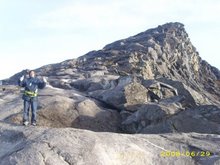Friday, July 24, 2009
Thursday, July 9, 2009
Melah Pinang
Mr. Semilan & grandchildren
posing at Metong longhouse
From left to right
Violetha Nangku Joe, Nona Luta
& Viacaterinie Suyah Joe
Mr. Ragai & group
Ritual 'Miring'
City visitors at Metong
longhouse
Bernard & Jessicia Wedding
on the 30/07/2009
at Metong longhouse
Posted by jasweiq at 9:48 PM 0 comments
Labels: Melah Pinang
Friday, July 3, 2009
Ulu Baram-My Visit

Ulu Baram pt.1

Ulu Baram pt.2

Ulu Baram pt. 3

Photo taken at Long Anap

Structure erected in front
Long Anap Long House
(Symbol Kemenangan)

Batu Niah

Posted by jasweiq at 8:24 PM 0 comments
Labels: Baram-My Visit
Gawai Dayak
GAWAI DAYAK (DAYAK FESTIVAL)
Gawai Day or Gawai Dayak is a festival celebrated in Sarawak on 1 June every year. It is both a religious and social occasion. The word Gawai means a ritual or festival whereas Dayak is a collective name for the native ethnic groups of Sarawak: the Iban, also known as Sea Dayak and the Bidayuh people, also known as Land Dayak. Thus, Gawai Dayak literally means "Dayak Festival". Dayak would visit their friends and relatives on this day. Such visit is more commonly known as "ngabang" in the Iban language. Those too far away to visit would receive greeting cards.
It started back in 1957 in a radio forum held by Mr Ian Kingsley, a radio programme organiser. This generated a lot of interest among the Dayak community.
The mode of celebration varies from place to place. Preparation starts early. Tuak (rice wine) is brewed (at least one month before the celebration) and traditional delicacies like penganan (cakes from rice flour, sugar and coconut milk) are prepared. As the big day approaches, everyone will be busy with general cleaning and preparing food and cakes. On Gawai Eve, glutinous rice is steamed in bamboo (ngelulun pulut). In the longhouse, new mats will be laid out on the ruai (an open gallery which runs through the entire length of the longhouse). The walls of most bilik (rooms) and the ruai are decorated with Pua Kumbu (traditional blankets). A visit to clean the graveyard is also conducted and offerings offered to the dead. After the visit it is important to bathe before entering the longhouse to ward off bad luck.
The celebration starts on the evening of 31 May. In most Iban longhouses, it starts with a ceremony called Muai Antu Rua (to cast away the spirit of greed), signifying the non-interference of the spirit of bad luck in the celebration. Two children or men each dragging a chapan (winnowing basket) will pass each family's room. Every family will throw some unwanted article into the basket. The unwanted articles will be tossed to the ground from the end of the longhouse for the spirit of bad luck.
Around 6 pm or as the sun sets, miring (offering ceremony) will take place. Before the ceremony, gendang rayah (ritual music) is performed. The Feast Chief thanks the gods for the good harvest, and asks for guidance, blessings and long life as he waves a cockerel over the offerings. He then sacrifices the cockerel and a little blood is used together with the offerings.
Once the offering ceremony is done, dinner is then served at the ruai. Just before midnight, a procession up and down the ruai seven times called Ngalu Petara (welcoming the spirit gods) is performed. During this procession, a beauty pageant to choose the festival's queen and king (Kumang & Keling Gawai) is sometimes conducted. Meanwhile, drinks, traditional cakes and delicacies are served.
At midnight, the gong is beaten to call the celebrants to attention. The longhouse Chief (tuai rumah) or Festival Chief will lead everyone to drink the Ai Pengayu (normally tuak for long life) and at the same time wish each other "gayu-guru, gerai-nyamai" (long life, health and prosperity). The celebration now turns merrier and less formal. Some will dance to the traditional music played, others will sing the pantun (poems). In urban areas, Dayaks will organise gatherings at community centres or restaurants to celebrate the evening.
Other activities that may follow the next few days include: cock-fighting matches, and blowpipe and ngajat competitions. On this day, 1 June, homes of the Dayaks are opened to visitors and guests.
Traditionally, when guests arrive at a longhouse, they are given the ai tiki as a welcome. From time to time, guests are served tuak. This would be called nyibur temuai which literally means "watering of guests".
Christian Dayaks normally attend a church mass service to thank God for the good harvest.
Gawai Dayak celebrations may last for several days. It is also during this time of year that many Dayak weddings take place, as it is one of the rare occasions when all the members of the community return home to their ancestral longhouse.
Up till 1962, the British colonial government refused to recognise Dayak Day. Gawai Dayak was formally gazetted on 25 September 1964 as a public holiday in place of Sarawak Day. It was first celebrated on 1 June 1965 and became a symbol of unity, aspiration and hope for the Dayak community. Today, it is an integral part of Dayak social life. It is a thanksgiving day marking good harvest and a time to plan for the new farming season or activities ahead.
Posted by jasweiq at 6:51 PM 0 comments
Labels: Gawai Dayak



















